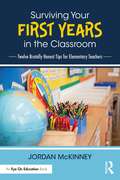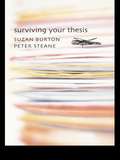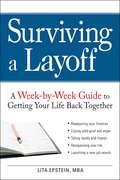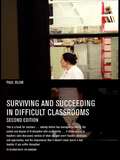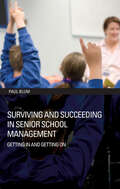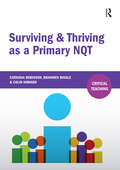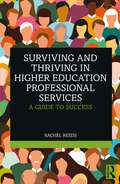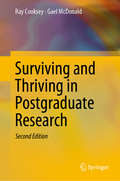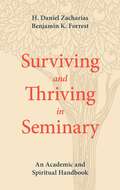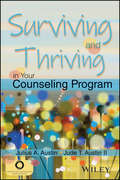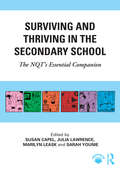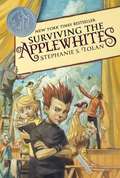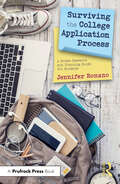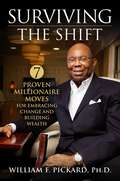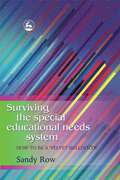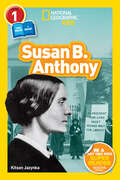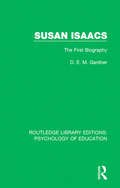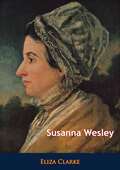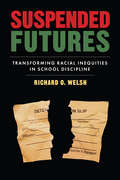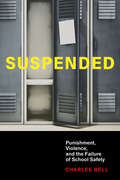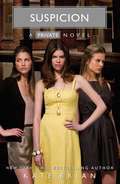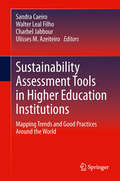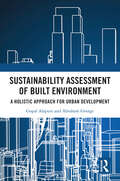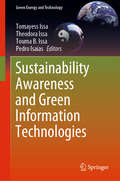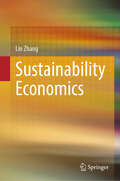- Table View
- List View
Surviving Your First Years in the Classroom: Twelve Brutally Honest Tips for Elementary Teachers
by Jordan McKinneySurvive your first years as a teacher with the no-nonsense tips and stories in this book. Learn how to choose respect over being liked, content over cute, grace over grades, and planning over Pinterest. Also find out how to avoid the teacher’s lounge mentality and surround yourself with positive influences. The author’s honest tone and humor throughout will leave you feeling inspired and ready to tackle the challenges that can come your way, so you can stay happy in your role and remember why you chose a career in education. Bonus: The book features a variety of worksheets you can use immediately, on lesson planning, student behavior and motivation, and more.
Surviving Your Thesis
by Suzan Burton Peter SteaneFrom choosing a supervisor and topic to staying motivated, completing a research thesis is not an easy matter. Each stage represents a different challenge and many students struggle through without identifying the skills needed to make the most of their time. This wonderful resource for all doctoral and masters level students, explores the challenges and complexities of successfully engaging in the research process and thesis writing. Chapters include: choosing and working with a supervisor developing a research proposal motivating yourself choosing the right research method responding to criticism advice from the examiners preparing work for publication. This clear and practical guide, ideal for all doctoral and masters level students, takes readers from the very early stages of the process through to the final phase of examination and publication, using vignette examples to highlight key issues.
Surviving a Layoff: A Week-by-Week Guide to Getting Your Life Back Together
by Lita EpsteinBeing laid off is a traumatic event. Downsized workers must face decisions about reorganizing their lives and their finances, while grappling with the emotional grief of losing a job. This book is a practical guide to dealing with the tough questions a layoff poses. Using a week-to-week timeline, the book offers advice on such topics as: coping with grief and anger after a downsizing; reorganizing life after a layoff; how to launch a job search; balancing the job search with family and personal time; explaining a layoff to family and friends; and more. This book will show downsized workers how to reorganize schedules, set financial and organizational priorities, and go for their next job with confidence and enthusiasm.
Surviving and Succeeding in Difficult Classrooms
by Paul BlumFollowing the success of the first edition, this revised second edition, brings the reader up-to-date with what it is like to be a teacher in a difficult class, and regularly faced with apathy, defiance and aggression. Sadly, numerous government initiatives since the 1998 publication of the first edition have not transformed the situation for teachers in difficult classrooms. Here, Paul Blum explores the impact and consequences of the changes made in the intervening years. Like its predecessor it offers sensible, practical advice, for all classroom teachers, on how to survive and succeed in the face of tremendous difficulty, and this updated edition includes new sections on teaching pupils with low reading ages, and on making the most effective use of teaching assistants.
Surviving and Succeeding in Senior School Management: Getting In and Getting On
by Paul BlumThis lively, practical account explores the vital aspects of the assistant or deputy headteacher’s role, which often means playing piggy-in-the-middle to a variety of school stakeholders, including the headteacher, other senior managers, the teaching staff, parents and local authority advisors, governors and pupils. The author gives practical tips on how to organise yourself well when the pressure to perform multiple tasks simultaneously is high, such as how to lead and manage major strategic changes, do a good presentation to staff on a training day, and give a rogue pupil an effective telling-off. The book also covers how to apply for a senior management job and successfully get through the stringent written selection criteria and complex interview process. This is a highly informative text for any aspiring subject leader or middle manager in the primary or secondary sector. It will also be of interest to existing senior managers who want to reflect on the way they are doing their job already.
Surviving and Thriving as a Primary NQT (Critical Teaching)
by Colin Howard Catriona Robinson Branwen BingleThis book is essential reading for your year as a primary newly qualified teacher (NQT). It provides support through advice, reassurance and practical strategies, and encourages you to critically reflect on your experiences so that you can get the most from your induction period.Term by term, the book guides you through the transition from trainee teacher to becoming a confident class teacher responsible for the organisation, management and learning of the pupils in your charge. All aspects of life in the classroom are considered, from the practicalities of setting up and resourcing the classroom and creating displays to more strategic level thinking about leading learning and wider school responsibilities. The text tackles key issues such as classroom organisation, homework, writing Individual Education Plans, record keeping and the use of data for tracking pupil progress, and engaging with pupils, parents, colleagues and outside agencies. The final section focuses on the end of induction and what lies beyond for your future career in teaching.
Surviving and Thriving in Higher Education Professional Services: A Guide to Success
by Rachel ReedsDiving into the vibrant, challenging world of professional services in higher education, this empowering book provides tools to navigate complex structures, optimise mentorship, and thrive in a fulfilling career.Whether you're a newcomer, a seasoned professional seeking advancement, or someone caught between academic and professional worlds, this book offers practical advice for success in UK higher education professional services. You’ll learn strategies for navigating career paths, tackling change with confidence, cultivating a growth mindset, and developing strong communication, leadership, and problem-solving skills. Diverse stories from real-life professionals will guide you through a dynamic and unique career journey.The guidance and advice within this comprehensive book will equip you with strategies for filling knowledge gaps, finding the right mentor, and fostering an inclusive team environment. Embrace challenges, build resilience, and unlock your full potential in the ever-evolving world of UK higher education professional services.
Surviving and Thriving in Postgraduate Research
by Ray Cooksey Gael McDonaldThis handbook provides an in-depth exploration of the entire journey of postgraduate research in the social and behavioural sciences, from enrolment to its culmination in the form of a thesis, dissertation or portfolio, and beyond. It is written in an accessible and example-rich style, offering practical and concrete advice in virtually all areas. It also includes references to additional resources and websites, and each chapter features key recommendations for improving the postgraduate research experience. The book addresses not only research-related aspects (e.g. supervisors; selecting your guiding assumptions; contextualising, framing and configuring research; reviewing literature; sampling; writing proposals; ethics and academic integrity; selecting a data gathering strategy; surviving your thesis/dissertation/portfolio examination; and publishing), but also questions concerning how to integrate, manage, and balance the research journey in the context of the postgraduate student’s broader life-world (e.g. skill development and supervisor relations; effective time and project management; a healthy work–life balance; maintaining motivation; and dealing with criticism). The book adopts an explicitly pluralist perspective on postgraduate research, moving beyond mixed methods thinking, and offers concrete examples from postgraduate students’ real-world experiences.
Surviving and Thriving in Seminary: An Academic and Spiritual Handbook
by H. Daniel Zacharias Benjamin K. ForrestSeminary can be rich and rewarding, but also disorienting. In addition to the typical challenges of doing graduate studies, your experiences in seminary affect how you see God, other people, and yourself. The stakes are high, but the good news is that you're not alone on this journey. In Surviving and Thriving in Seminary, two experienced professors (and former seminary students) guide you through what to expect and how to navigate your years in seminary. They tell you what they tell their own students--and what they wish they'd heard themselves. You'll get practical advice on how to prepare your own heart and relationships, how to manage your time and energy, and how to acquire the study skills you need. This essential book encourages and equips current and soon-to-be students to get the most out of their time in seminary.
Surviving and Thriving in Your Counseling Program
by Jude Austin Julius Austin“Drs. Julius and Jude Austin have written a most informative and engaging guide for students navigating the demands of their academic program and internships. They provide practical wisdom in each chapter and serve as mentors to their readers through their self-disclosure and the lessons they have learned. This book needs to be in the hands of every counseling student, as it offers extremely useful pointers and encouragement to survive and thrive in their program.” —Marianne Schneider Corey, MA, LMFT, NCC —Gerald Corey, EdD, ABPP, NCC Professor Emeritus of Human Services and Counseling California State University, Fullerton “This is a valuable resource for students in graduate-level training in counseling or counselor education and supervision. In addition, it will be a useful update for counselor educators regarding the experiences of contemporary graduate counseling students.” —Richard E. Watts, PhD, LPC-S Sam Houston State University Written for graduate students who want to get the most out of their experience, this book presents down-to-earth discussions and suggestions on counselor training and life after graduation. The authors, both millennials and recent doctoral program graduates, draw upon their own personal and professional training and career experiences, as well as shared insight from a diverse group of current graduate students, recent graduates, and new professionals. The realistic, personal, and often humorous narratives throughout the book give an insider’s perspective on graduate school and illuminate the emotional journey of students and new professionals. Topics include choosing and getting into a program, handling the opportunities and challenges that each year of the program presents, gaining emotional maturity, dealing with setbacks, managing conflicts, increasing cultural awareness, getting a doctoral degree, searching for a job, finding a supervisor, and obtaining licensure. Readers will also be able to peek behind the curtains of faculty meetings to glean what faculty members expect, develop skills for their first session, and create and maintain a self-care plan for improving work-life balance. *Requests for digital versions from the ACA can be found on wiley.com. *To request print copies, please visit the ACA website here. *Reproduction requests for material from books published by ACA should be directed to permissions@counseling.org Julius A. Austin, PhD, isa clinical therapist and coordinator for the Office of Substance Abuse and Recovery at Tulane University. Jude T. Austin II, PhD, is an assistant professor and clinical coordinator in the Professional Counseling Program at the University of Mary Hardin-Baylor.
Surviving and Thriving in the Secondary School: The NQT's Essential Companion (Learning to Teach Subjects in the Secondary School Series)
by Julia Lawrence Marilyn Leask Sarah Younie Susan CapelWith an emphasis on developing a reflective, resilient approach that will ensure both effective teaching and teacher well-being, Surviving and Thriving in the Secondary School covers key issues that may be encountered in the day-to-day practice of teaching in the secondary school. With evidence-based practice at the forefront, this volume allows new teachers to avoid common pitfalls of teaching and it will help provide a new-found confidence within the classroom. Including a wide range of tasks that will help guide and demonstrate successful practice, this book covers topics and concerns such as: Building relationships within teaching Managing and responding to change Becoming an inclusive educator Working to improve classroom climate and pupil behaviour Assessment, homework and marking Inclusion of digital technologies and ICT Looking after yourself and your professional development Surviving and Thriving in the Secondary School can be utilised to help support and provide ideas on specific areas of concern, or it can be read as a continuing professional development (CPD) companion, allowing practice to be developed and refined. Written by world-renown experts in the field, this volume provides support for all newly qualified teachers and is an essential resource for the first year of teaching and beyond.
Surviving the Applewhites
by Stephanie S. TolanWill anyone take on Jake Semple?<P><P> Jake Semple is notorious. Rumor has it he burned down his old school and got kicked out of every school in his home state.<P> Only one place will take him now, and that's a home school run by the Applewhites, a chaotic and hilarious family of artists. The only one who doesn't fit the Applewhite mold is E.D.-a smart, sensible girl who immediately clashes with the unruly Jake.<P> Jake thinks surviving this one will be a breeze... but is he really as tough or as bad as he seems?<P> Newbery Honor book
Surviving the College Application Process: A Pocket Research and Planning Guide For Students
by Jennifer RomanoThe college admissions landscape and the steps to apply can be overwhelming and confusing! This mini guide is a quick resource highlighting key components to consider in the effort to decode and demystify the college application process for the college-bound student and their family. Covering topics such as essential application components, standardizing testing, personal statements, and financial aid, Surviving the College Application Process is your secret weapon for navigating the college research, planning, and selection process. Light-hearted and accessible, this book can be read from cover to cover or referenced as needed by college-bound students, their families, school counselors, and anyone interested in post-secondary education.
Surviving the Shift: 7 Proven Millionaire Moves for Embracing Change and Building Wealth
by William F. Pickard, PhDA positive attitude, the ability to adapt to change, and the willingness to learn from failure . . . these are all good markers of a successful person. But what does it take to become a successful entrepreneur—someone who can create something out of nothing? Someone who can start from the bottom and work their way to the top? In Dr. William Pickard&’s new book Surviving the Shift, this is exactly what he provides. As one of the country&’s most successful Black entrepreneurs, Dr. Pickard knows a thing or two about overcoming failure and mistakes to become an extraordinary entrepreneur. In this book, he details the highs and lows of his entrepreneurial evolution and offers seven proven principles for embracing change and building wealth. Surviving the Shift will teach you how to: · Develop positive vision and attitude. · Prepare for opportunities. · Understand that financing is not that difficult. · Build good relationships. · Choose a team with the right talent and skill set. · Learn from failure. · Cultivate strong faith. Successful entrepreneurship requires a shift in thinking, planning, and doing. It requires avoiding the many pitfalls people often face in business. Whether you are a new college graduate ready to make your mark on the world, someone who is trying to figure out the next step for their career, an aspiring entrepreneur, or you want to explore new ways to grow your business, you have the power to become the person you were meant to be. This book is your road map, and Dr. Pickard has equipped you with everything you need for your journey.
Surviving the Special Educational Needs System: How to be a ‘Velvet Bulldozer'
by Sandy RowSome children's 'difficulties' do not present in an obvious way, which makes diagnosis problematic, and access to help unforthcoming. This was the experience of Sandy Row, who, after a decade of misdiagnoses and unsatisfactory explanations for her children's struggle in mainstream school, realised that her children had special educational needs (SEN) and began her long quest for help from the SEN system. Row's testimony illustrates how the special educational needs system works and empowers other parents to demand help for their children who have special educational needs that require attention. This frank and practical book challenges the theoretical and often impenetrable established literature on SEN, and instead provides an accessible and effective resource for those needing advice and answers about their rights to services and help for their children.
Susan B. Anthony (Readers)
by Kitson JazynkaMeet one of the most important figures in women's and U.S. history. Just in time for the 100th anniversary of the 19th amendment giving U.S. women the right to vote, learn about Susan B. Anthony's remarkable life, from her childhood to her groundbreaking work.National Geographic Kids Readers have been a hit in the beginning reader category, and this book builds upon that success with a new approach--parents and children reading together. With the same combination of careful text, brilliant photographs, and fun approach to high-interest subjects that has proved to be a winning formula with kids, National Geographic Co-readers provide one page of adult read-aloud and one page of kid read-aloud text on each spread, building toward a collaborative reading experience.
Susan Isaacs: The First Biography (Routledge Library Editions: Psychology of Education)
by D.E.M. GardnerOriginally published in 1969, this is the first biography of Susan Isaacs, the first attempt to estimate her incalculable contribution to the theory and practice of the education of young children. As a pioneer of new teaching methods, Susan Isaacs will be remembered mainly for her work at the Malting House School in Cambridge in the 1920s, and her contribution was such that in 1933 the Department of Child Development at the University of London, Institute of Education was specially created for her; she was Head of the Department until 1943. But Susan Isaacs was also a psychoanalyst, and D.W. Winnicott in his Foreword refers to the time when he was supplying cases for her child analysis training: ‘I watched with interest her sensitive management of the total family situation, a difficult thing when one is engaged in learning while carrying out a psycho-analytic treatment involving daily sessions over years.’ D.E.M. Gardner, who was a close friend as well as student of Susan Isaacs, begins by describing Susan’s childhood in a Lancashire cotton town, and throughout the book she helps us to feel the force of Susan’s personality and intellect – ‘she was a truly great person, one who has had a tremendous influence for good on the attitude of parents and of teachers to the children in their care’.
Susanna Wesley
by Eliza ClarkeThis life of Susanna Wesley, the mother of John Wesley the founder, and of Charles Wesley the poet, of Methodism, differs from previous ones in not being written from a sectarian nor even from an eminently religious point of view. Having been much associated with those who had been in familiar inter course with Charles Wesley's widow and children, and having heard Susanna Wesley continually spoken of as a woman who underwent and overcame more difficulties than most, the ideal of her life early aroused my imagination. I was delighted with the opportunity of writing her memoir, and have done so with the sympathetic admiration natural to one in whose veins runs some of her blood, however much diluted.
Suspended Futures: Transforming Racial Inequities in School Discipline (Race and Education)
by Richard O. WelshAn incisive examination of the school discipline crisis and a strategic, evidence-driven playbook for educational decision-makers who aim to resolve disciplinary disparities
Suspended: Punishment, Violence, and the Failure of School Safety
by Charles BellThe disturbing truth: school suspension does more than impede Black students' academic achievement—it also impacts their parents' employment and can violate state and federal laws.Decades of urban disinvestment and poverty have made educational attainment for Black youth more vital than at any time in recent history. Yet in their pursuit of quality education, many Black families are burdened by challenging barriers to success, most notably the frequency and severity of school punishment. Such punishment is meant to be a disciplinary tool that makes schools safer, but it actually does the opposite—and is particularly harmful for Black students and their families.Focusing on schools in inner-city and suburban Detroit, Charles Bell draws on 160 in-depth interviews with Black high school students, their parents, and their teachers to illuminate the negative outcomes that are associated with out-of-school suspension. Bell also sheds light on the inherent shortcomings of school safety measures as he describes how schools fail to protect Black students, which leaves them vulnerable to bullying and victimization. The students he interviews offer detailed insight into how the lack of protection they received in school intensified their fear of being harmed and even motivated them to use violence to establish a reputation that discouraged attacks. Collectively, their narratives reveal how receiving a suspension for fighting in school earned them respect, popularity, and a reputation for toughness—transforming school punishment into a powerful status symbol that destabilizes classrooms.A thought-provoking and urgent work, Suspended calls for an inclusive national dialogue on school punishment and safety reform. It will leave readers engrossed in the students' and parents' tearful narratives as they share how school suspension harmed students' grades, disrupted parents' employment, violated state and federal laws, and motivated families to withdraw from punitive districts.
Suspicion: A Private Novel
by Kate BrianForbidden fruit... Reed, Noelle, and former Billings Girls Kiran and Taylor have been living it up on St. Barths over winter break. The tropical sun has melted away all the tensions of last semester, and for the first time in months, Reed is happy. She's got her best friends by her side, she has a palatial suite with an ocean view, and she's landed Upton, the most sought-after guy on the island. Reed is falling in love. But dating Upton makes Reed St. Barths' highest-profile guest -- and not in a good way. Upton has a dark past, and he's broken a lot of hearts. One of his exes still wants him. And she'll do whatever it takes to get Reed out of the picture.
Sustainability Assessment Tools in Higher Education Institutions
by Walter Leal Filho Sandra Caeiro Charbel Jabbour Ulisses M. AzeiteiroThis book contributes to debates on current sustainability practices, with a focus on assessment tools as applied in higher education institutions. These institutions are challenged to carry out management, research, and teaching, and to create settings that allow developing new competencies to address the complex global environmental, social, cultural, and economic pressures with which current and future generations are confronted. The first chapters discuss issues of sustainability in higher education, namely the role of universities in promoting sustainability and the emergent fields of sustainability science and education for sustainable development and how to integrate and motivate sustainability into the university. Subsequent chapters present examples of sustainability assessment tools specifically developed for higher education institutions, such as the AISHE - Auditing Instrument for Sustainability in Higher Education, the GASU - Graphical Assessment of Sustainability in Universities too, the STAUNCH - Sustainability tool for Auditing Universities Curricula in Higher Education. The use of other integrated tools are also presented. The papers have adopted a pragmatic approach, characterized by conceptual descriptions, including sustainability assessment and reorienting the curricula, on the one hand, and practical experiences on the other, with good practices from different edges of the world. Sustainability Assessment Tools in Higher Education Institutions will be of interest to graduate student, lecturers, researchers, and those setting university policy.
Sustainability Assessment of Built Environment: A Holistic Approach for Urban Development
by Gopal Alapure Abraham GeorgeThis book focuses on developing a holistic sustainability assessment model for built environment that can help in identifying sustainability issues and parameters for the built environment. It covers a wide range of sustainable built form issues in the local and regional contexts.The volume identifies significant built form sustainability indicators, criteria and sub-criterion while highlighting the importance of incorporating sustainability principles and assessment of sustainability. It also discusses the data collection process for defining priorities of sustainability parameters using the Analytic Hierarchy Process (AHP) technique. The book presents information to obtain fuzzy weights to classify assessed built form. The chapters in this book explain the development of an integrated built environment assessment system for infrastructure projects.This book will be of interest to students, teachers and researchers of planning, architecture, construction, urban studies, interior designing, urban planning and civil engineering. It will also be useful for architects, planners, civil engineers, interior designers, builders, developers, green building assessors and those interested in the sustainable assessment-built environment and urban development.
Sustainability Awareness and Green Information Technologies (Green Energy and Technology)
by Pedro Isaias Tomayess Issa Theodora Issa Touma B. IssaThis book addresses several aspects of environmental sustainability awareness and priorization, explores ways to use resources and processes more responsibly, and describes the strategies, models and tools required to overcome various challenges. Sustainable and green IT are used to minimize the current ICT recycling problems which are harming our planet. The book discusses the new green information technologies as alternatives to conventional ICT, which have significantly harmed nature, and examines how to make recent technologies such as cloud computing; social networking; smart technology; blockchains, IoT (internet-of-things); and big data sustainable. Exploring sustainability awareness and importance among individuals and organizations in the developed and developing countries, most of the contributions conclude that sustainability should be considered a duty in order to change mindsets, attitudes and actions so as to preserve our planet. Furthermore, it examines the green information technology strategies and models.
Sustainability Economics
by Lin ZhangThis book is an essential guide to understanding and tackling the complex challenges of sustainable development.It provides a thorough analysis of economic principles and their application to pressing sustainability issues. Covering everything from foundational theories and energy dynamics to environmental impacts and social justice, it provides actionable insights into how businesses, policymakers, and communities can drive sustainable progress. With a focus on real-world applications, it explores the latest in energy efficiency, climate policy, and green finance, making it a critical resource for students, professionals, and anyone passionate about creating a more sustainable future. Whether you're looking to deepen your understanding of sustainability economics or seeking practical strategies for implementing sustainable practices, this book offers a rich blend of theory, analysis, and practical guidance.
